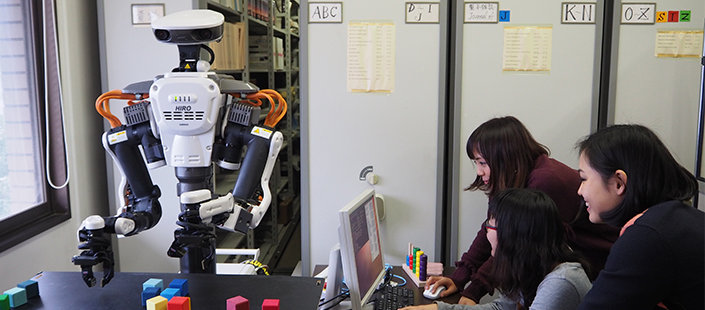- Top
- Information Science
ページの本文です。

Information Science
Information Science
The Science of Information—The Fundamental Technology of the Twenty-First Century
The information technology that enabled the development of computers in the twentieth century is now incorporated into cell phones and electrical appliances, and is dramatically transforming our everyday lives.
Information science is also attracting a great deal of attention as a means to analyze the mechanisms of nature, life, language and economics and make predictions about them. Information science holds endless possibilities as a methodology that can further improve our lives and contribute to every other discipline.
Teachers specializing in a variety of cutting-edge areas teach the courses in this department, providing a broad education from theory to practice. The program develops information science that is intimately tied to everyday life from the unique perspective of a women’s university.
Objective: Outstanding Employment Prospects on the Frontlines of Information Technology
To foster the researchers and engineers of the future, this program teaches first-year students the mechanisms of information technology, and shows them how computers work by providing many different programming courses. This program also provides a full range of courses on the theories that form the foundation of information technology. In other words, our program’s distinctive aspect is that it provides students with the practical knowledge required for working in the information industry as well as the opportunity to master the theoretical background that will be harder to learn about so comprehensively after entering society.
Approximately 70 to 80 percent of students continue on to graduate school, where they achieve an even higher level of specialization. They then work in cutting-edge workplaces at corporations and research institutes. The employment prospects for graduates of this program are extremely good, and Ochanomizu University is reportedly the number one university in Japan in terms of producing graduates employable by the telecommunications industry. The university website provides details regarding the employment situation, so please have a look.
Features: Teachers and Curricula That Can Support Various Interests
First- and second-year students take many courses on the mathematics and theories that form the basis of information science. Students build a solid foundation in programming by learning the basics with a practical training course they start in their first year, and time is also provided to solve seminar problems as part of courses in mathematics and theory. Since the classes are small, students can enjoy learning under a system that is always there for them. From the second year, students start attending lectures on information infrastructure technologies, including architecture and networks.
Lectures on advanced areas of information science start in the third year. Students greatly expand their perspectives on information science by taking courses that match their interests from a wide range of options, including computer science, mathematics and natural science. Fourth-year students select a laboratory that matches their interests and engage in graduate research under the careful instruction of their teachers. Students then proactively present their research results both inside and outside the university, and overseas as well.
Introduction to Computer Systems
Students acquire basic knowledge regarding computer systems and their roles in the real world. This class covers topics that include the principles and mechanisms of computers, history, and the various technologies at the core of information science.
Exercises in Multimedia Programming
This course uses the Java language and trains students in the basics of multimedia programming to ensure that they understand and can use object-oriented concepts.
Fundamentals of Mathematics
Students learn about symbolic logic—the foundation of all mathematics—which is essential in the recognition, meaning and calculation of programming and natural languages, and is also used in the design of electronic circuits.
Computer Graphics
This course teaches students about the basic theories and advanced technologies behind the generation of images using computer graphics. Students are challenged to freely create programs. The course also covers visualization technology that can be used to understand data so that students can freely analyze data.
Information Theory
This course covers fundamental theories of information and communications from the basic concept “what is information?” to the mathematical theories that underly the practical technologies used to quantify information.







